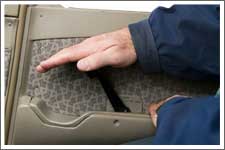
The following stories from the July 11, 2008, edition of AOPA ePilot were provided to AOPA members who expressed an interest in the particular subject areas. Any AOPA member can receive information tailored to their areas of interest by updating their preferences online.
| My ePilot Training Tips |
| OPEN DOORS Pilots can attest that a door coming unsecured in flight is more than an artificial distraction; it's a common real-world occurrence. Keeping the problem in perspective maintains safety if your calm, orderly cockpit suddenly becomes a loud, windy place. "If a door opens in flight, particularly on takeoff, ignore it! Fly the airplane. Stay in the pattern, and then land and close the door (it would be prudent to determine why the door opened before taking off again). If for some reason you can't return and land, depart the pattern normally, get into straight and level flight at a safe altitude and check traffic. Then think about closing the door," explains "Open door in flight" on AOPA Flight Training Online. New pilots are surprised to learn that the typical aircraft suffers little impediment from an open cockpit door. "Although some airplanes are adversely affected by the door opening in flight, most are not, and will fly normally with the door open. If you find yourself with the door open in flight, remember to fly the airplane first. Follow the instructions in your pilot's operating handbook to secure the door in flight or land as soon as possible," reiterates the AOPA Air Safety Foundation's article "Is your cabin door closed and locked?" Before your next flight, get acquainted with the comprehensive discussion of this subject in Chapter 16 of the Airplane Flying Handbook . Then review the door-open checklist in your pilot's operating handbook, guaranteeing your readiness to handle this well-known cause of distraction. |
| Training Products |
| KING SCHOOLS SPORT PILOT GET-IT-ALL KIT Note: Products listed have not been evaluated by ePilot editors unless otherwise noted. AOPA assumes no responsibility for products or services listed or for claims or actions by manufacturers or vendors. |
| My ePilot Final Exam |
| Question: On the airport diagram for McCarran International in Las Vegas, the numbers S30, D145, ST175, DT460, DDT833 are on the right-hand side of the diagram under runway headings. What do these numbers mean? Answer: These numbers state the respective runway weight-bearing capacity for various aircraft wheel configurations. The weights are expressed in thousands of pounds. In this example, S30 means the runway use is limited to a maximum of 30,000 pounds gross landing weight for single-wheeled aircraft (one wheel per strut). D145 reflects a maximum weight limitation of 145,000 pounds for dual-wheeled aircraft (two wheels per strut). ST stands for single tandem, DT stands for dual tandem, and DDT stands for double dual tandem. The published weight capacity of a runway must be approved by the local airport board and may be more restrictive than the actual runway capability to reduce heavy traffic and maintenance needs. Got a question for our technical services staff? E-mail to [email protected] or call the Pilot Information Center, 800/872-2672. Don't forget the online archive of "Final Exam" questions and answers, searchable by keyword or topic. |
 It happens to many pilots: A cabin door pops open in flight, sometimes just after takeoff. Although a rude surprise, this is something that the well-trained pilot handles with ease. Too bad such an easily remedied problem causes accidents, usually because a pilot was unprepared. Your training and flight test will include the handling of "realistic distractions." Your designated pilot examiner is required to confront you with a distraction on the checkride. Your job will be to demonstrate that you can focus on what's important—maintaining positive control of the aircraft—then resolving the distraction safely.
It happens to many pilots: A cabin door pops open in flight, sometimes just after takeoff. Although a rude surprise, this is something that the well-trained pilot handles with ease. Too bad such an easily remedied problem causes accidents, usually because a pilot was unprepared. Your training and flight test will include the handling of "realistic distractions." Your designated pilot examiner is required to confront you with a distraction on the checkride. Your job will be to demonstrate that you can focus on what's important—maintaining positive control of the aircraft—then resolving the distraction safely.

